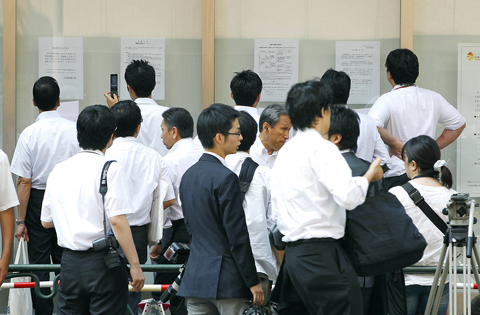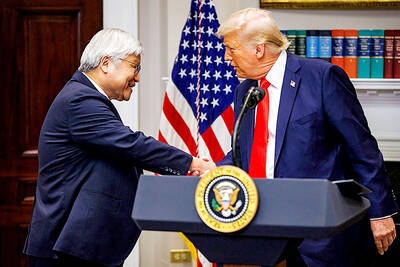The Japanese economy isn’t quite as weak as first thought, but it still needs help, the government said yesterday as it unveiled details of a new US$11 billion stimulus package.
Revised figures showed that GDP expanded at an annualized rate of 1.5 percent in the April-June period, an improvement on the meager 0.4 percent reported in last month’s preliminary report.
The latest numbers, which put Japan on par with US growth rates, are better but not great. Growth has fallen sharply since the 5 percent annualized rate recorded in the first quarter, and the future looks increasingly murky.

PHOTO: REUTERS
It was at least enough to buoy investor sentiment for the day.
The Nikkei 225 stock average led regional gains, finishing up 140.78 points, or 1.6 percent, at 9,239.17. The improved growth figure stemmed from higher capital spending by companies. Corporate investment expanded 1.5 percent, compared with 0.5 percent growth in the Cabinet Office’s preliminary figures.
The government, however, moved quickly to announce its latest plan to fend off worrying headwinds. Japanese Prime Minister Naoto Kan’s Cabinet approved ¥915 billion (US$10.9 billion) in new stimulus measures. The previously announced package aims to boost domestic consumption, fight deflation and tackle fallout from a strong yen, which hit a new 15-year high this week.
A strong yen is painful for the country’s vital exporters because it reduces the value of repatriated profits and makes their products less competitive overseas. Toyota Motor Corp has said that every ¥1 climb versus the dollar saps ¥30 billion from operating profit.
The fresh injection sets Japan apart from the rest of the developed world, which is winding down stimulus spending even amid signs of a cooling global economy. Since Kan revealed his plans last month, the package has been criticized by analysts as too little to make any meaningful impact.
The government says the package will lead to 200,000 new jobs and raise GDP by about 0.3 percent.
About half of the money will go toward extending consumer subsidy programs for energy-efficient homes and appliances. Other measures include job support programs for new graduates and steps to convince companies to keep jobs in Japan instead of moving factories overseas because of the strong yen.
“The direction, rather than the size of package, is extremely important,” Japanese Chief Cabinet Secretary Yoshito Sengoku said, according to Kyodo news agency.
The government said it would “continue to monitor movements and adopt decisive measures when necessary. It also expressed hope that the central bank would work with the government to enact additional policy measures if needed.
Hamstrung by massive debt, the government will not issue new bonds to fund the emergency measures. It will instead tap into a reserve fund in this year’s budget.
Meanwhile, the private Incubator Bank of Japan (IBJ) has been ordered to halt operations and was to file for bankruptcy yesterday, in what would be Japan’s first bank failure in seven years, officials said.
Government officials said the bankruptcy would have little impact on the Japanese financial system, however.
The Financial Services Agency has told the bank it cannot do any business for at least three days and must make efforts to protect existing depositors, the agency said in a statement.
The Nikkei Shimbun and other Japanese media said the agency was likely to let the bank go under and would only refund depositors a maximum of ¥10 million. This would be the first time that a cap on deposit insurance had been used in Japan.
The Tokyo-based bank may report a negative net worth of ¥180 billion, the public broadcaster NHK and Jiji Press reported, without citing sources.
Japanese Financial Services Minister Shozaburo Jimi said in a statement that the IBJ was to file for bankruptcy yesterday at the Tokyo District Court.
“It’s extremely regrettable that the situation occurred. I hope depositors remain cool-headed as up to ¥10 million in deposits will be protected,” he said.
It would be the first bankruptcy in Japan’s banking sector since 2003. However, Bank of Japan Governor Masaaki Shirakawa issued a statement saying the failure of IBJ does not pose a threat and would not have “an adverse impact on the stability of Japan’s financial system.”

A Chinese freighter that allegedly snapped an undersea cable linking Taiwan proper to Penghu County is suspected of being owned by a Chinese state-run company and had docked at the ports of Kaohsiung and Keelung for three months using different names. On Tuesday last week, the Togo-flagged freighter Hong Tai 58 (宏泰58號) and its Chinese crew were detained after the Taipei-Penghu No. 3 submarine cable was severed. When the Coast Guard Administration (CGA) first attempted to detain the ship on grounds of possible sabotage, its crew said the ship’s name was Hong Tai 168, although the Automatic Identification System (AIS)

An Akizuki-class destroyer last month made the first-ever solo transit of a Japan Maritime Self-Defense Force ship through the Taiwan Strait, Japanese government officials with knowledge of the matter said yesterday. The JS Akizuki carried out a north-to-south transit through the Taiwan Strait on Feb. 5 as it sailed to the South China Sea to participate in a joint exercise with US, Australian and Philippine forces that day. The Japanese destroyer JS Sazanami in September last year made the Japan Maritime Self-Defense Force’s first-ever transit through the Taiwan Strait, but it was joined by vessels from New Zealand and Australia,

SECURITY: The purpose for giving Hong Kong and Macau residents more lenient paths to permanent residency no longer applies due to China’s policies, a source said The government is considering removing an optional path to citizenship for residents from Hong Kong and Macau, and lengthening the terms for permanent residence eligibility, a source said yesterday. In a bid to prevent the Chinese Communist Party (CCP) from infiltrating Taiwan through immigration from Hong Kong and Macau, the government could amend immigration laws for residents of the territories who currently receive preferential treatment, an official familiar with the matter speaking on condition of anonymity said. The move was part of “national security-related legislative reform,” they added. Under the amendments, arrivals from the Chinese territories would have to reside in Taiwan for

CRITICAL MOVE: TSMC’s plan to invest another US$100 billion in US chipmaking would boost Taiwan’s competitive edge in the global market, the premier said The government would ensure that the most advanced chipmaking technology stays in Taiwan while assisting Taiwan Semiconductor Manufacturing Co (TSMC, 台積電) in investing overseas, the Presidential Office said yesterday. The statement follows a joint announcement by the world’s largest contract chipmaker and US President Donald Trump on Monday that TSMC would invest an additional US$100 billion over the next four years to expand its semiconductor manufacturing operations in the US, which would include construction of three new chip fabrication plants, two advanced packaging facilities, and a research and development center. The government knew about the deal in advance and would assist, Presidential